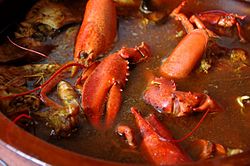You can help expand this article with text translated from the corresponding article in Catalan. (January 2012)Click [show] for important translation instructions.
|
Balearic cuisine is a Mediterranean cuisine as cooked in the Balearic Islands, Spain. It can be regarded as part of a wider Catalan cuisine, since it shares many dishes and ingredients with Catalonia and the Valencian Community. [1] Others view it as part of a more global Spanish cuisine. Traditional Balearic cuisine is rich in vegetables, cereal and legumes as well as being low in fats. A succinct selection of the primary dishes would be ensaimades , seafood and vegetable stews, sobrassada , coques , tombet , Maó cheese, almonds, and wine. [2]
Contents


![Coca de trempo [es], typical in summer in the Balearic Islands Coca de trempo.jpg](http://upload.wikimedia.org/wikipedia/commons/thumb/5/5c/Coca_de_tremp%C3%B3.jpg/250px-Coca_de_tremp%C3%B3.jpg)


